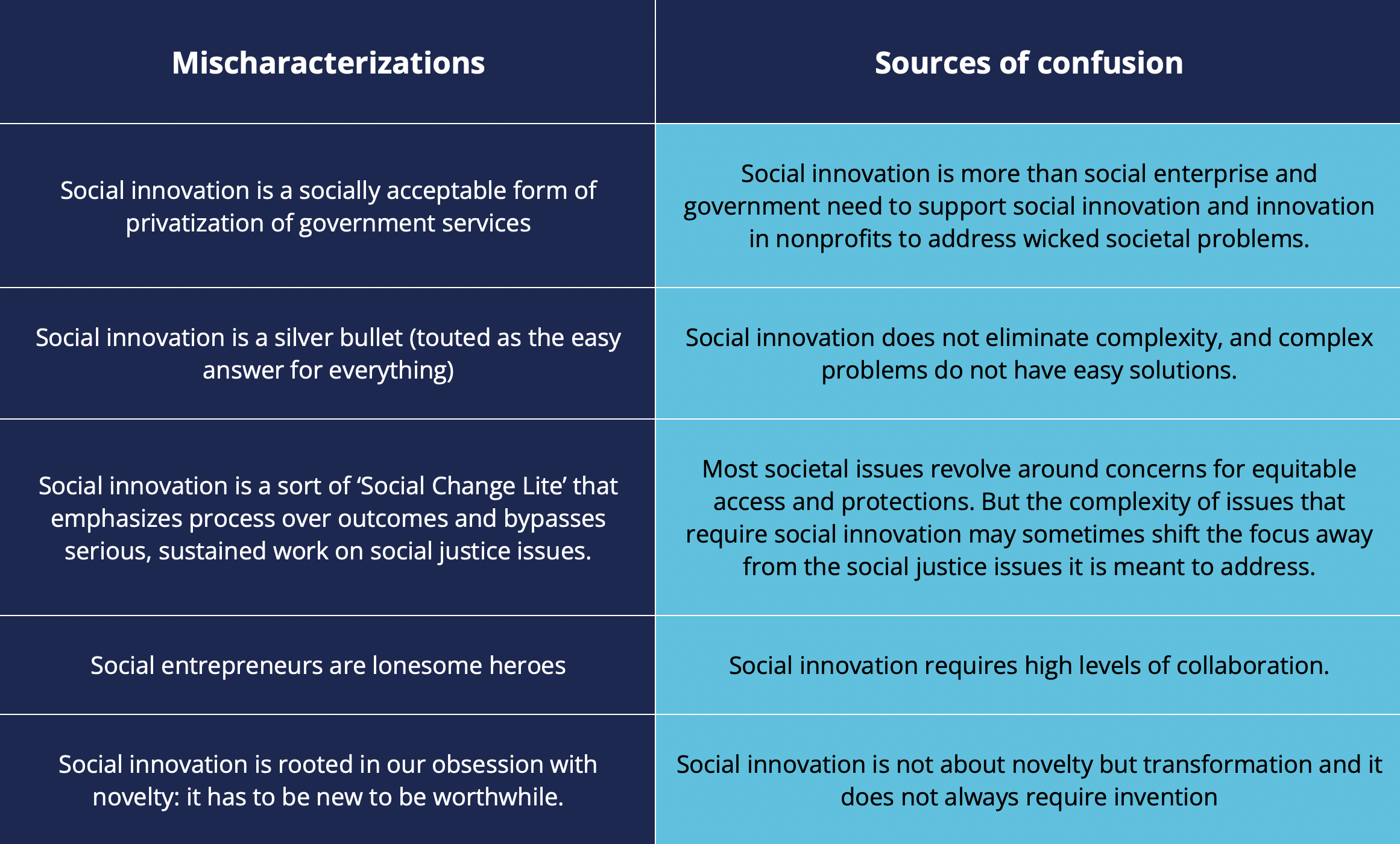By the end of this unit, participants will be able to:
- Demonstrate an understanding of how good intentions do not always produce positive outcomes.
- Recognize the role of reflection in preventing unintended consequences in social innovation context.
Background
Despite the fact that it rests on good intentions and the will to make things better, social innovation and its pursuit can have negative outcomes, often for the very people whose well-being it was intended to improve. Likewise, changemakers may end up being their own worst enemies when they pursue change without first taking the time to reflect and understand their own needs and interests, those of the people they are aiming to support, and their role in the change they want to bring about.
This unit is shorter than the other units to leave space and time for project work as teams complete their final tasks. It examines the unintended consequences of innovation, and how to avoid them. It also addresses the issue of overcoming the apprehension that may arise when the problems one faces seem daunting and one’s perceptions of one’s own ability in face of their magnitude make it difficult to know what the first step should be.
This unit also takes a closer look at the idea of reflective practice, introducing the notion that reflection is a necessary aspect of social innovation. You may have noticed that each of the units have time dedicated to reflection, whether it is the questions in the case studies or the partner engagement section. Pursuing action without making time to reflect and regularly take stock of what is happening, and what could be happening differently can lead one to overlook critical information about and signals from the context as well as valuable engagement opportunities.Core Concepts
Social Innovation is not an Absolute Good
…someone working in the homelessness initiative in the U.S. […]decided that they were going to tackle the most pressing manifestation of the problem. In New York, it happened to be young, unemployed males who were living on the streets. Their surveys showed the largest percentage of the homeless were in that group, so they said, “let’s address that.” They zeroed in and asked “What do these people need? What are their particular issues? How can we create certain kinds of housing or work arrangements that meet their needs?” And they were very successful. They began to pull large numbers of these people off the streets and then they started to notice that violence towards street women was going up astronomically. They didn’t know that having young men on the street was a deterrent to violence to street women, but they suddenly discovered a new problem because of their solution to the last problem.” – (Cahill and Spitz)
The process of change does not end with the emergence of innovation and/or once a system has been successfully transformed. Innovation often takes on a life of their own. Invention in one area may create demand for more innovation in another. Likewise, a new product, program or policy that is implemented with good intentions may ultimately have negative consequences. Here are some examples.
The World Wide Web
Tim Berners Lee who is often credited as a driving force behind the spread of the World Wide Web in the 1990s has recently drawn attention to some of the detrimental effects of the technology. According to him, while the rise of social media was initially celebrated by many of its champions for having the potential to democratize access to information and promoting collaboration across geographies, other downstream impacts have been widely felt: the rise of disinformation and increased polarisation have had consequences on individuals’ mental health, cultures and institutions that raise questions about the positive impacts of Web 2.0.
Single Use Medical and Protective Equipment
Personal protective equipment, such as hospital gowns, masks, gloves are single use supplies, and medical devices, such as thermometers and syringes, increase safety by reducing the risk of infection and cross-contamination. The byproduct of the technical innovation designed to reduce risk, i.e. a great deal of waste, however, call for further innovation to address their consequences on the environment.
Celebrity Endorsements
Since the 1980s, public personalities have increasingly been expected to use their cultural and economic capital to support global aid organizations and humanitarian initiatives. Celebrities such as Angelina Jolie and Bono have used their immense influence and resources to make considerable contributions to public awareness, support, and financing of various charity initiatives. However, celebrity endorsements may have unintended downsides. By endorsing a cause that appeals to them, a celebrity is able to rally considerable attention and resources to the cause. Yet, they may also indirectly pull support away from other initiatives whose needs and mandate may be equally or even more urgent. Likewise, charities associated with celebrities suddenly facing a scandal may incur reputational loss. Even in the best cases, the involvement of a celebrity may channel resources away from those who need it: when a celebrity make an appearance or “on site” visit, they require accommodations, guides and security that can end up absorbing most of the funding raised for the cause they are supporting.
Critiques of Social Innovation
Just like any other approach or theory, social innovation should be scrutinized and be put to the test. And just like any other approach or theory, it is likely to evolve. However, some critics of social innovation may also mischaracterize or misunderstand what it involves. Below are examples of misdirected criticism:
Figure 11.1. Mischaracterizations and Sources of Confusion.
For the most part, these mischaracterizations are the result of a poor understanding and/or application of the theories that underpin social innovation approaches, which are rich and sophisticated and – like most scientific theories – require sustained engagement. Moreover, the change brought about by social innovation takes place over time, often a very long time, and its effects are rarely attributable to the action of a single person. Therefore, any proposal that is presented as capable of creating impressive changes quickly is likely not aligned with the methodologies that lead to positive transformative social change. Social innovation is often intended to tackle issues that call for involvement at both the grassroots and the high tops, as well as all levels in-between. The level of connectivity this requires is such that one can’t just walk away whenever one wants without consequences and without being noticed.
However, some critiques of social innovation raise important concerns. For example, the rationale for government’s investment in increasing non-profits’ capacity for social enterprise has sometimes been that this would lead to long-term savings. The twofold assumption here is, on the one hand that social innovation can be reduced to social enterprise (which is false), and that adopting social enterprise models would lead organizations to become more inventive and manage to do more with less, and that this would ultimately mean that less would need to be invested by government in supporting the social sector (which unproven).
The situation is similar when community funders restructure their support and focus grant opportunities around “innovation” and proceed to reduce the availability of funds that are necessary for non-profits to support ongoing/existing operations or projects. Read more this process here Social innovation is not the Holy Grail.
To be in a better position to contribute, it is crucial to attend to the multifaceted aspects and use the methods and tools associated with social innovation while practicing reflection at every step of the way.
Practicing Reflection
“If we attempt to act and do things for others or the world without deepening our own self-understanding, our own freedom, integrity, and capacity to love, we will not have anything to give to others. We will communicate nothing but the contagion of our own obsessions, our aggressiveness, our own ego-centred ambitions.” (Thomas Merton, Trappist Monk)
Figure 11.2. Tightrope Walker from the BBC: https://www.bbc.co.uk/newsround/61594871.
Imagine a tightrope walker. Before they move from the solid platform to the edge, they pause. They often close their eyes. They breathe deeply and become still. They work to centre themselves, to become deeply aware of their internal state – physically, mentally, emotionally, and perhaps even spiritually. They are focused on themselves as well as their surroundings. Preparing. Observing. Waiting for signals indicating that they are ready, and that the moment is right. And then, they step forward; aware, attentive and alert, moving purposefully along the narrow rope, high above the ring.
The example of the tightrope walker’s indispensable focus and centredness illustrates the critical value of equivalent practices in in social innovation context. The same type of centeredness is essential for system mediators and social innovation practitioners who learn and work at the edges of what they know and what they can imagine, i.e. in contexts of emergence. Reflection practices are ways to bring about this centredness.
Practicing reflection requires the ability to assess one’s own actions, to take a critical stance or attitude toward one’s own practice, and to be willing to engage in a continuous process of adaptation and learning.
Reflection is fundamental to building the self-awareness and internal strength needed to challenge personal assumptions, manage despair, maintain hope, and seed creativity. Reflection deepens self-awareness and is tightly connected to learning and the understanding that informs action.
Reflective practice is also the first step to prevent that one become overwhelmed. It provides an opportunity to ask, “what troubles me about what is happening around me?” and to take the time to listen to the answer that may lessen the grip of anxieties.
Beware of unproductive assumptions like:
- Taking the time to reflect is a loss of time.
- The only thing that truly matters is action.
- Reflection is a pointless quest for answers and the persistence of questions.
Reflection is a form of action!
At first, practicing reflection is difficult: it may serve to reveal more additional questions rather than provide answers. However, it is important to avoid the rush, or the sensation to be moving as fast as possible without considering first what we are doing or where we are going.
Reflection, in addition to openness to learning about different perspectives and ways of thinking, helps prevent missed opportunities to create meaningful change.
The process of change does not end with the emergence of innovation and/or once a system has been successfully transformed. Innovation can often take on a life of their own: a new product, program or policy that is implemented with good intentions may ultimately have negative consequences. Examples include: the World Wide Web, single use medical and protective equipment and celebrity charity
Just like any other approach or theory, social innovation should be scrutinized, put to the test and encouraged to evolve. However, some critics of social innovation may also misunderstand what it involves.
To be in a better position to contribute, it is crucial to attend to the multifaceted aspects and use the methods and tools associated with social innovation while practicing reflection at every step of the way. Practicing reflection requires the ability to assess one’s own actions, to take a critical stance or attitude toward one’s own practice and to be willing to engage in a continuous process of adaptation and learning.
Beware of unproductive assumptions like:
- Taking the time to reflect is a loss of time.
- The only thing that truly matters is action.
- Reflection is a pointless quest for answers and the persistence of questions.
Reflection is fundamental to building the self-awareness and internal strength needed to challenge personal assumptions, manage despair, maintain hope and seed creativity.
Reflective practice is also the first step in managing overwhelm to lessen the grip of anxieties.
Slides
Partner Engagement
Assignments





